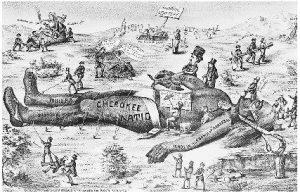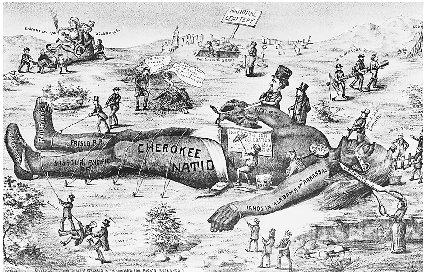
It is impossible to overestimate the historical significance of a cartoon that made fun of Georgia after the 1831 ruling by the U.S. Supreme Court in the Cherokee Nation v. Georgia case. A third man, standing in for the state of Georgia, watches as two white men pull a Native American man against his will in the cartoon, which was published in the Jacksonian-opposing Washington Globe in 1832. The atrocities that Native American tribes faced in the early 19th century are significantly more understood because of this paper.
A significant legal conflict that took place at the start of the 19th century was the Cherokee Nation v. Georgia case. The Cherokee Nation, which is present-day Georgia, fought to retain control over and ownership of their historic territory. Georgia, however, asserted its control over Cherokee territory and intended to forcibly evict the Native American tribes to make space for European settlers. In the end, the Cherokee Nation lost because the Supreme Court determined that they were ineligible to challenge the state of Georgia since they were a “domestic dependent nation.” This choice prepared the way for the dreadful Trail of Tears, during which many Cherokee and other Native American tribes were forcibly transported to reservations in modern-day Oklahoma, leading to a significant number of fatalities from malnutrition, disease, and other causes.
A harsh criticism of the state’s treatment of the Cherokee Nation is made in the cartoon ridiculing Georgia in response to the Supreme Court’s ruling and the events that followed. The depiction of a Native American man being forcibly taken from his home by white men brings to light the violence and injustice that Native American nations at the time experienced. Georgia is shown in the cartoon as the third figure, highlighting the government’s involvement in these events. A potent reflection on the injustices experienced by Native American tribes may be seen in the anonymous artist’s use of caricature to represent the harshness and disrespect shown by white males against Native Americans.
The Cherokee Indians and the Supreme Court by Stephen Breyer goes into more detail about the case and its effects. Breyer points out that although the Cherokee Nation thought it had the right to manage its own territory as a sovereign nation, the Supreme Court ultimately disagreed with them. More details about the case and its effects are available in the article “Cherokee Nation v. Georgia: The Case and Its Impact” by Elianna Spitzer. Spitzer points out that many people died as a result of the ruling, which permitted the Cherokee Nation to be forcibly removed from their native lands and relocated to reservations in modern-day Oklahoma. The Cherokee Nation was prevented from suing the state of Georgia as a result of the Supreme Court’s ruling, which resulted in their forcible removal from their ancestral lands, according to the Thirteen website page “Landmark Cases of the Supreme Court: Cherokee Nation v. Georgia.”
In light of the Cherokee Nation v. Georgia lawsuit, the cartoon criticizing Georgia serves as a potent and enduring reminder of the injustices experienced by Native American tribes in the early 19th century. The document’s severe critique of the role played by the government in evicting Native Americans from their ancestral lands emphasizes how crucial it is to acknowledge and comprehend the effects of colonialism and imperialism. The cartoon serves as a crucial historical artifact by highlighting a terrible and frequently ignored period in American history through its visual choices and substance.
Breyer, Stephen. “The Cherokee Indians and the Supreme Court.” Journal of Supreme Court History, vol. 87, no. 3/4, 2003, pp. 408–426.
Spitzer, Elianna. “Cherokee Nation v. Georgia: The Case That Predated the Trail of Tears.” ThoughtCo, ThoughtCo, 4 Nov. 2020.
“The Supreme Court . The First Hundred Years . Landmark Cases . Cherokee Indian Cases (1830s): PBS.” The Supreme Court . The First Hundred Years . Landmark Cases . Cherokee Indian Cases (1830s) | PBS.

this article seems to bring home the little known hidden rottennous of the foundations of our so called greatest democratic nation and seems to verify the old adage…indeed that the road to hell is paved with good intentions